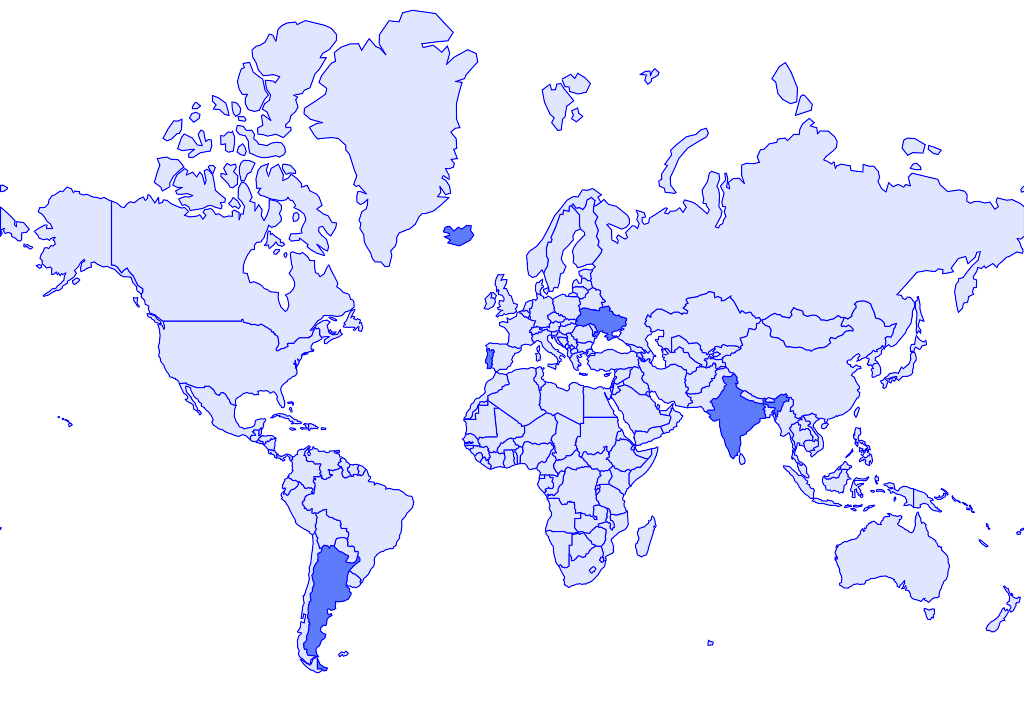Worldize is a very simple and naive gem to make world map, with countries painted according to some values (see also choropleth map).
Code:
worldize = Worldize::Countries.new
img = worldize.draw # Magick::Image of RMagick
img.write('blank.png')You can set some options (see Usage for details):
worldize = Worldize::Countries.new
img = worldize.draw(ocean: '#3A3C3C', land: 'black', border: 'yellow')
img.write('night.png')Code:
Worldize::Countries.new.
draw_highlighted('Ukraine', 'Argentina', 'Portugal', 'India', 'Iceland').
write('highlighted.png')Code:
Worldize::Countries.new.
draw(
'Ukraine' => '#FCF83D',
'Argentina' => '#FE7ECD',
'Portugal' => '#FD1F30',
'India' => '#108400',
'Iceland' => 'white'
).
write('colors.png')worldize = Worldize::Countries.new
# create hash like {country name => value}
values = {
'Argentina' => 100,
'Bolivia' => 50,
'Chile' => 180
#...
}
worldize.
draw_gradient(
'#D4F6C8', # gradient from this color
'#247209', # ...to that color
values # ...according to value
).
write('gradient.png')NB: on this picture, countries associated with values according to their position in sorted countries list, just like this:
values = worldize.country_names.sort.each_with_index.to_a.to_h
# => {"Afghanistan"=>0, "Albania"=>1, "Algeria"=>2, "Angola"=>3, "Antarctica"=>4, "Argentina"=>5, "Armenia"=>6, ...It's gem, named worldize. Do your usual [sudo] gem install worldize
or adding gem 'worldize' to Gemfile routine.
Create an object: w = Worldize::Countries.new.
Synopsys: #draw('Country1' => 'color1', 'Country2' => 'color2', ... , option: value)
Country can be either full name or
ISO 3-letter code.
For list of known names/codes there are service functions #country_names
and #country_codes.
color is any color value RMagick can understand
(for ex., hex-codes or common color names).
Options awailable:
widthof resulting image (default 1024 pixels, height will be calculated automatically);land—default color of land (for countries not specified in list);ocean—color of ocean;border—color of country borders.
Both countries and options can be omitted completely (resulting in all countries being drawn in default color).
Synopsys: #draw_selected('Country1', 'Country2', ... , option: value).
Options are the same as for #draw plus :selected background color
(reasonable default exists, so can be omitted).
Synopsys: #draw_gradient('from_color', 'to_color', 'Country1' => value1, 'Country2' => value2, ... option: value)
Values should be numeric and colors will be scaled to gradient between
from_color and to_color.
Use worldize --help for details.
Highlight countries:
worldize -o highlighted.png \
--highlight-countries Ukraine,Argentina,Portugal,India,Iceland
Colors for countries:
worldize -o color.png \
--paint-countries "Ukraine:#FCF83D,Argentina:#FE7ECD,Portugal:#FD1F30,India:#108400,Iceland:white"
or from CSV file
worldize -o color.png \
--paint-countries country_colors.csv --csv-columns 0,1
means firs and second columns contain country name and color. Or from CSV with headers:
worldize -o color.png \
--paint-countries country_colors.csv
--csv-headers --csv-columns Country,Color
Color-coded statisitcs
worldize -o gradient.png \
--from-color '#D4F6C8' --to-color '#247209' \
--grad-countries "Argentina:100,Bolivia:50,Chile:180"
or from CSV file, like above:
worldize -o gradient.png \
--from-color '#D4F6C8' --to-color '#247209' \
--grad-countries country_stats.csv --csv-headers --columns "Country,Population 2015"
- Country borders are taken from geojson (sourced from Natural Earth by OpenData license);
- Web Mercator map projection calculated according to formulae;
- Result is cropped to exclude polar areas (which has nothing interesting in any case!);
- RMagick for drawing, awesome color gem for gradients calculation.
(or not TODO, depends on whether somebody needs this)
- Options to draw legend and other text labels;
- Use of some open-licensed tiles/picture of the world as background image.
MIT.




